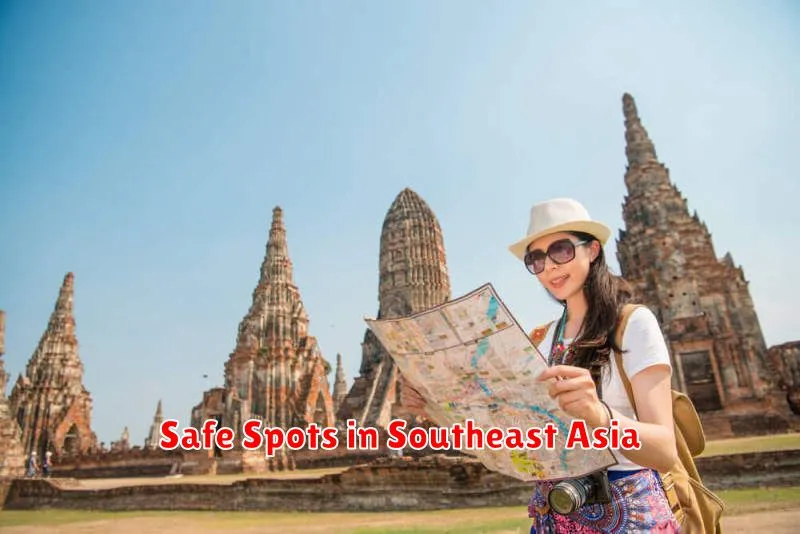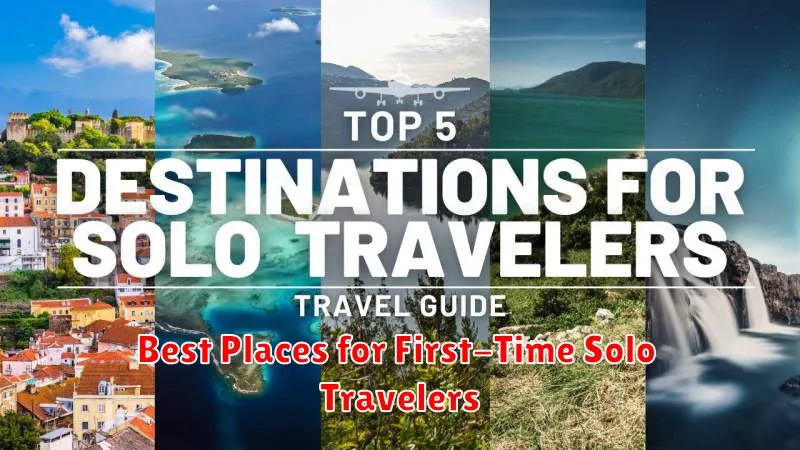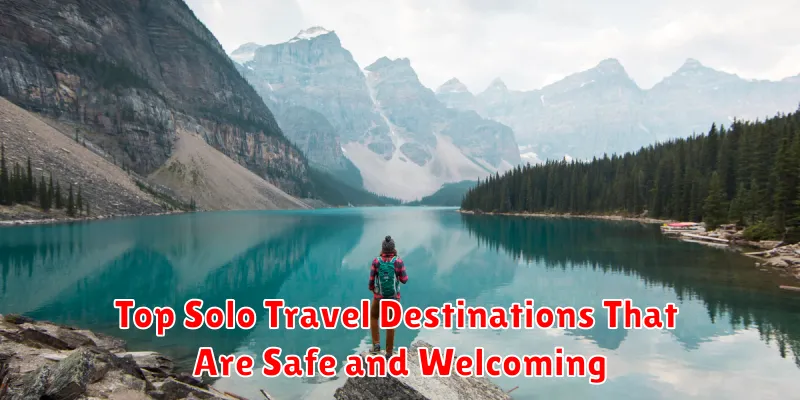Embarking on a solo adventure can be an incredibly rewarding experience. Discovering new cultures, exploring at your own pace, and fostering self-reliance are just a few of the many benefits. But with the thrill of independent travel comes the important consideration of safety and finding welcoming destinations. This article explores some of the top solo travel destinations that prioritize both, allowing you to experience the joys of solo exploration with peace of mind. Whether you’re a seasoned solo traveler or preparing for your first independent trip, we’ll highlight destinations known for their safety, hospitality, and ease of navigation for solo explorers. Discover the perfect backdrop for your next solo travel journey, combining enriching experiences with a secure and welcoming environment.
From bustling cities with efficient public transportation to tranquil towns with a strong sense of community, our list of safe and welcoming destinations caters to a variety of travel styles. Whether you seek cultural immersion, breathtaking natural landscapes, or thrilling outdoor adventures, you’ll find inspiration for your next solo trip. We’ll delve into the specific aspects that make these locales ideal for solo travelers, including low crime rates, accessible transportation options, and a culture of hospitality towards visitors. Get ready to discover a world of possibilities for your next solo adventure in destinations that prioritize your safety and welcome you with open arms.
What Makes a Destination Solo-Friendly
A solo-friendly destination prioritizes safety and ease of navigation. This means clear signage, reliable public transportation, and a low crime rate. Feeling secure exploring independently is paramount for solo travelers. Destinations with readily available tourist information, easily accessible accommodations, and a welcoming local population further enhance the solo experience.
Beyond practical considerations, solo-friendly destinations often offer activities conducive to independent exploration. Think museums, historical sites, hiking trails, and opportunities to connect with local culture through cooking classes or workshops. Destinations with a variety of options cater to different interests, allowing solo travelers to personalize their itineraries and discover new passions.
Finally, a strong sense of community can elevate a solo trip. Destinations with readily available social events, group tours, or communal dining experiences offer opportunities for connection and shared experiences. While embracing solitude is a key aspect of solo travel, the option to interact with others can enrich the journey and combat potential loneliness.
Europe’s Most Welcoming Cities
Determining Europe’s “most welcoming” cities is subjective and depends on various factors, but consistently high-ranking cities include Amsterdam, known for its open-minded culture and English proficiency. Dublin also receives accolades for its friendly locals and vibrant pub scene, which fosters social interaction. Copenhagen, frequently cited for its safe and accessible environment, also projects a welcoming atmosphere.
Other cities often mentioned include Lisbon, with its sunny disposition and affordable cost of living attracting a diverse crowd. Porto, also in Portugal, shares similar characteristics and boasts a strong sense of community. In Spain, Seville’s passionate culture and historic charm create a warm and inviting ambiance.
Factors influencing perceptions of welcomeness can include language accessibility, ease of navigation, local attitudes towards tourists, and overall safety. While these cities consistently rank high, individual experiences may vary. Research and planning are crucial to ensuring a positive visit to any destination.
Safe Spots in Southeast Asia

Southeast Asia offers a diverse range of experiences for travelers, but safety is a key consideration. Generally, Singapore and Brunei are considered the safest countries in the region, boasting low crime rates and stable political environments. Malaysia, Thailand, and Vietnam also offer relatively safe travel experiences, especially in tourist hubs. However, it’s important to exercise vigilance and be aware of petty theft, scams, and traffic hazards, particularly in crowded areas.
Within each country, certain areas are known for being particularly safe. In Thailand, Chiang Mai and Hua Hin have reputations for being tranquil and secure. Malaysia’s Penang and Melaka are generally safe for visitors. In Vietnam, Hoi An and Da Nang are considered safer compared to larger cities like Ho Chi Minh City or Hanoi. Remember that perceptions of safety can be subjective, and local regulations and conditions can change. It’s crucial to stay informed about current events and advisories before and during your trip.
Regardless of your destination, practicing common sense safety measures will enhance your security. These include safeguarding your belongings, avoiding walking alone at night in isolated areas, and being respectful of local customs. Researching your destination beforehand, obtaining travel insurance, and registering with your embassy are also strongly recommended for a safer and more enjoyable Southeast Asian adventure.
Solo Travel in South America
South America offers a diverse and exciting landscape for solo travelers. From the ancient ruins of Machu Picchu to the vibrant streets of Buenos Aires, the continent has something for everyone. Safety is a key concern, and thorough research and planning are crucial. Sticking to well-lit and populated areas, especially at night, is advisable. Learning some basic Spanish or Portuguese will significantly enhance your experience and allow for greater interaction with locals. Being aware of your surroundings and keeping valuables secure are important precautions no matter where you travel.
Budgeting wisely is another crucial aspect of successful solo travel in South America. Accommodation options range from budget-friendly hostels to luxurious hotels, allowing you to tailor your trip to your financial comfort. Street food and local markets offer delicious and affordable meal options. Transportation within cities is typically efficient and inexpensive, utilizing buses or metros. Considering the varying exchange rates and planning your expenditures accordingly will help you maximize your travel fund. Flexibility is key, as unexpected delays or changes in plans are not uncommon.
Some popular destinations for solo travelers include:
- Medellin, Colombia
- Buenos Aires, Argentina
- Cusco, Peru
- Guayaquil, Ecuador
Remember to research visa requirements for your nationality and pack accordingly for the varied climates you might encounter. Most importantly, be open to new experiences and embrace the adventure!
Best Places for First-Time Solo Travelers

Embarking on your first solo adventure can be both exhilarating and daunting. Choosing the right destination is key to a positive experience. Southeast Asia is often recommended for its affordability, ease of travel, and welcoming culture. Countries like Thailand, Vietnam, and Malaysia offer a blend of bustling cities, tranquil beaches, and delicious cuisine, making them perfect for dipping your toes into solo travel. Organized tours and readily available transportation options make navigating these countries straightforward, even for beginners. The abundance of other travelers also provides ample opportunities to socialize and connect if desired.
Europe also presents fantastic options, especially for those interested in history, art, and culture. Cities like Amsterdam, Copenhagen, and Dublin are known for their walkability and safe environments. Furthermore, Europe’s extensive rail network simplifies travel between countries, allowing for easy exploration of multiple destinations. While potentially more expensive than Southeast Asia, Europe offers numerous budget-friendly accommodation options, including hostels and guesthouses, which can enhance the solo travel experience.
If you’re looking for natural beauty and outdoor adventures, consider Costa Rica. Its lush rainforests, volcanic landscapes, and pristine beaches provide a wealth of activities, from surfing and hiking to wildlife spotting. While perhaps requiring a bit more planning, the friendly locals and organized eco-tourism initiatives create a welcoming and supportive environment for solo travelers. Costa Rica strikes a balance between adventure and relaxation, making it a rewarding destination for your first solo journey.
Cultural Warmth and Hospitality
Cultural warmth and hospitality are integral aspects of many societies around the world. They encompass the ways in which communities express welcome, kindness, and generosity towards both locals and visitors. These expressions can manifest in various forms, from simple gestures like a smile or offering directions to more elaborate customs such as sharing meals or providing accommodations. Ultimately, they contribute to a sense of belonging and connection, fostering positive social interactions and strengthening interpersonal relationships.
The significance of cultural warmth and hospitality can be seen in their impact on tourism and intercultural understanding. Welcoming communities attract visitors, fostering economic growth and promoting cross-cultural exchange. When travelers experience genuine kindness and generosity, they gain valuable insights into different cultures and develop a deeper appreciation for diversity. This, in turn, can contribute to breaking down stereotypes and building bridges between different communities.
While cultural warmth and hospitality are often expressed through traditional customs, their essence lies in the spirit of generosity and kindness. Regardless of the specific practices, the underlying principle is to make others feel comfortable, respected, and valued. This can be as simple as offering a helping hand or a kind word. These acts of kindness, however small, can have a profound impact on individuals and communities, creating a more positive and welcoming world.
Local Support and Language Barriers
Accessing local support is crucial for individuals navigating new environments, particularly when facing language barriers. Language barriers can significantly impact access to essential services such as healthcare, education, and legal aid. Establishing strong local support networks can help bridge this communication gap and ensure individuals receive the necessary assistance.
Community organizations, religious institutions, and cultural centers often play a vital role in providing linguistic and cultural support. These resources can offer translation services, language classes, and cultural orientation programs. Additionally, utilizing bilingual staff and volunteers within service-providing organizations can greatly improve accessibility for non-native speakers.
Overcoming language barriers also requires proactive communication strategies from both service providers and individuals seeking support. Utilizing visual aids, simplified language, and translation technologies can facilitate understanding. Encouraging cultural sensitivity training for staff members can further enhance communication and create a more welcoming environment.

